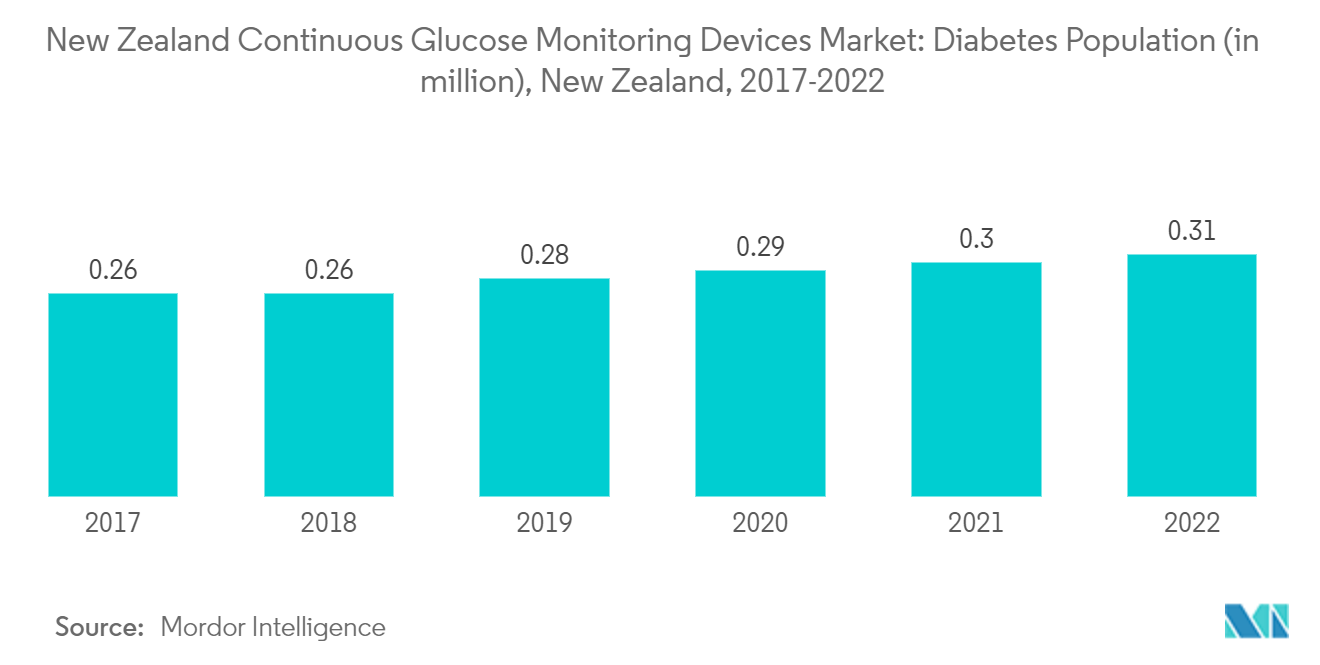Market Trends of New Zealand Continuous Glucose Monitoring Devices Industry
Increasing diabetes prevalence
Diabetes prevalence in New Zealand is projected to see significant growth during the forecast period, with approximately 360,000 people by 2028. There is a double burden because rates are higher and outcomes worse among Māori and Pasifika, and they typically face more significant socio-economic hardship. Type 1 diabetes is strongly linked to a family history of the condition, but the exact cause is unknown. No modifiable factors increase the risk for type 1 diabetes, although maintaining a healthy lifestyle is essential for managing the symptoms and long-term complications associated with the condition.
People are at a higher risk of getting type 2 diabetes. Major biomedical risk factors for type 2 diabetes are impaired fasting glucose and impaired glucose tolerance, high blood pressure, dyslipidemia, overweight and abdominal obesity, and behavioral risk factors, including unhealthy diets, insufficient physical activity, and smoking.
According to the New Zealand Health Survey by the Ministry of Health, the prevalence of obesity in New Zealand adults was around 34% in 2021-2022. There are many complications developed because of diabetes, including stroke, kidney disease, nerve damage, hearing loss, hypertension, eye complications, foot complications, skin complications, etc. Therefore, there is a need to monitor the blood glucose levels of patients with diabetes constantly. Lowering blood sugar is the first step in the treatment of diabetes, as patients who have diabetes need to be monitored so that their blood glucose levels do not go beyond the expected value. Using CGMs for people with Diabetes and their caregivers and communities is beneficial for managing their blood glucose and insulin levels to maintain their health outcomes.
CGM makes it significantly easier to control blood glucose levels by decreasing interruptions, allowing for better sleep, and improving the mental health of patients or caregivers by reducing the overall cognitive load of managing Diabetes. CGMs are widely used in children with Type-1, enabling parents to feel safer, allowing other adults to care for their child, giving children more freedom and autonomy in their day-to-day lives, and enabling access to more normal experiences and opportunities.
The rising prevalence of diabetes and growing awareness regarding diabetic care further drives the market for Continuous glucose monitoring devices in New Zealand.

The sensors segment held the highest market share in the current year
The sensors segment held the highest market share of about 80% in the current year.
To use a CGM, a small sensor is inserted into the abdomen (or arm) with a tiny plastic tube known as a cannula penetrating the top layer of skin. An adhesive patch holds the sensor in place, allowing it to take glucose readings in interstitial fluid (the fluid that surrounds cells in the body) day and night. Generally, the sensors must be replaced every 7 to 14 days. A small, reusable transmitter connected to the sensor allows the system to send real-time readings wirelessly to a monitor device that displays blood glucose data. Some systems have a dedicated monitor, and some display the information via a smartphone app.
Depending on the manufacturer, a CGM sensor can be used continuously for several days or weeks. Three glucose monitoring systems are currently available for private purchase in New Zealand: the Freestyle Libre (a flash monitoring system that requires manual checking rather than automatic data transmission), the Medtronic, and the Dexcom. Each system includes disposable/consumable sensors that must be changed approximately every ten days. Some of these can be purchased as part of a 12-month payment plan and on an individual purchase basis.
In January 2023, Abbott's cutting-edge diabetes technology was approved in New Zealand, costing the same as the original FreeStyle Libre Glucose Monitoring device. To allow users to sleep through the night and be awakened only when necessary, this gadget has optional and programmable alarms that notify them of essential glucose levels. The new product launches in New Zealand are further expected to affect the market positively over the forecast period.


